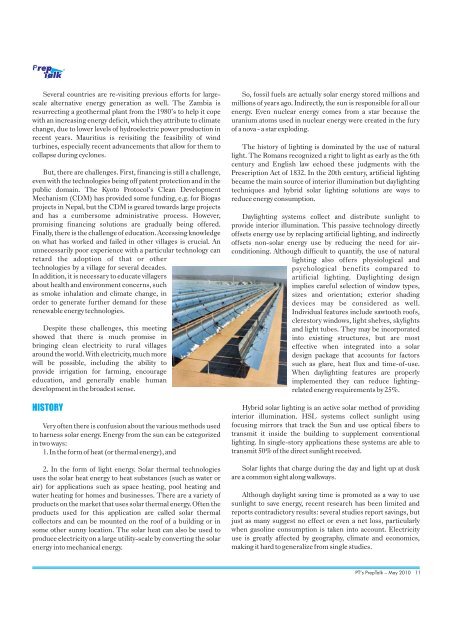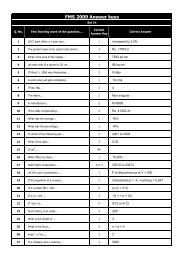Untitled - Student Resources Centre - PT education
Untitled - Student Resources Centre - PT education
Untitled - Student Resources Centre - PT education
Create successful ePaper yourself
Turn your PDF publications into a flip-book with our unique Google optimized e-Paper software.
Several countries are re-visiting previous efforts for largescalealternative energy generation as well. The Zambia isresurrecting a geothermal plant from the 1980’s to help it copewith an increasing energy deficit, which they attribute to climatechange, due to lower levels of hydroelectric power production inrecent years. Mauritius is revisiting the feasibility of windturbines, especially recent advancements that allow for them tocollapse during cyclones.But, there are challenges. First, financing is still a challenge,even with the technologies being off patent protection and in thepublic domain. The Kyoto Protocol’s Clean DevelopmentMechanism (CDM) has provided some funding, e.g. for Biogasprojects in Nepal, but the CDM is geared towards large projectsand has a cumbersome administrative process. However,promising financing solutions are gradually being offered.Finally, there is the challenge of <strong>education</strong>. Accessing knowledgeon what has worked and failed in other villages is crucial. Anunnecessarily poor experience with a particular technology canretard the adoption of that or othertechnologies by a village for several decades.In addition, it is necessary to educate villagersabout health and environment concerns, suchas smoke inhalation and climate change, inorder to generate further demand for theserenewable energy technologies.Despite these challenges, this meetingshowed that there is much promise inbringing clean electricity to rural villagesaround the world. With electricity, much morewill be possible, including the ability toprovide irrigation for farming, encourage<strong>education</strong>, and generally enable humandevelopment in the broadest sense.HISTORYVery often there is confusion about the various methods usedto harness solar energy. Energy from the sun can be categorizedin two ways:1. In the form of heat (or thermal energy), and2. In the form of light energy. Solar thermal technologiesuses the solar heat energy to heat substances (such as water orair) for applications such as space heating, pool heating andwater heating for homes and businesses. There are a variety ofproducts on the market that uses solar thermal energy. Often theproducts used for this application are called solar thermalcollectors and can be mounted on the roof of a building or insome other sunny location. The solar heat can also be used toproduce electricity on a large utility-scale by converting the solarenergy into mechanical energy.So, fossil fuels are actually solar energy stored millions andmillions of years ago. Indirectly, the sun is responsible for all ourenergy. Even nuclear energy comes from a star because theuranium atoms used in nuclear energy were created in the furyof a nova - a star exploding.The history of lighting is dominated by the use of naturallight. The Romans recognized a right to light as early as the 6thcentury and English law echoed these judgments with thePrescription Act of 1832. In the 20th century, artificial lightingbecame the main source of interior illumination but daylightingtechniques and hybrid solar lighting solutions are ways toreduce energy consumption.Daylighting systems collect and distribute sunlight toprovide interior illumination. This passive technology directlyoffsets energy use by replacing artificial lighting, and indirectlyoffsets non-solar energy use by reducing the need for airconditioning.Although difficult to quantify, the use of naturallighting also offers physiological andpsychological benefits compared toartificial lighting. Daylighting designimplies careful selection of window types,sizes and orientation; exterior shadingdevices may be considered as well.Individual features include sawtooth roofs,clerestory windows, light shelves, skylightsand light tubes. They may be incorporatedinto existing structures, but are mosteffective when integrated into a solardesign package that accounts for factorssuch as glare, heat flux and time-of-use.When daylighting features are properlyimplemented they can reduce lightingrelatedenergy requirements by 25%.Hybrid solar lighting is an active solar method of providinginterior illumination. HSL systems collect sunlight usingfocusing mirrors that track the Sun and use optical fibers totransmit it inside the building to supplement conventionallighting. In single-story applications these systems are able totransmit 50% of the direct sunlight received.Solar lights that charge during the day and light up at duskare a common sight along walkways.Although daylight saving time is promoted as a way to usesunlight to save energy, recent research has been limited andreports contradictory results: several studies report savings, butjust as many suggest no effect or even a net loss, particularlywhen gasoline consumption is taken into account. Electricityuse is greatly affected by geography, climate and economics,making it hard to generalize from single studies.<strong>PT</strong>’s PrepTalk – May 2010 11
















